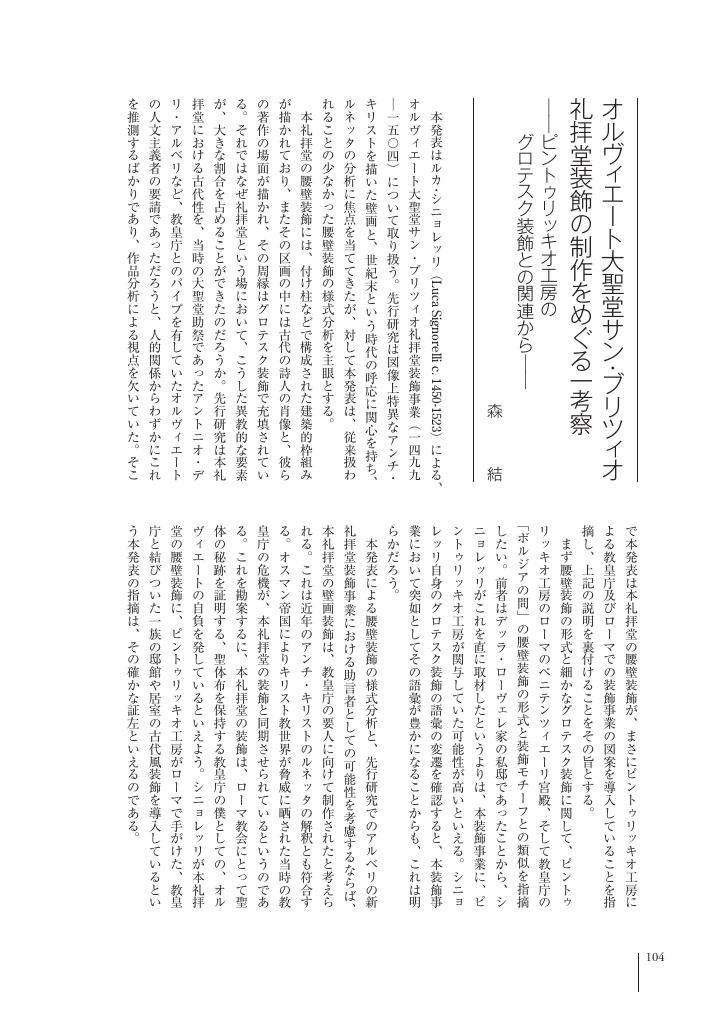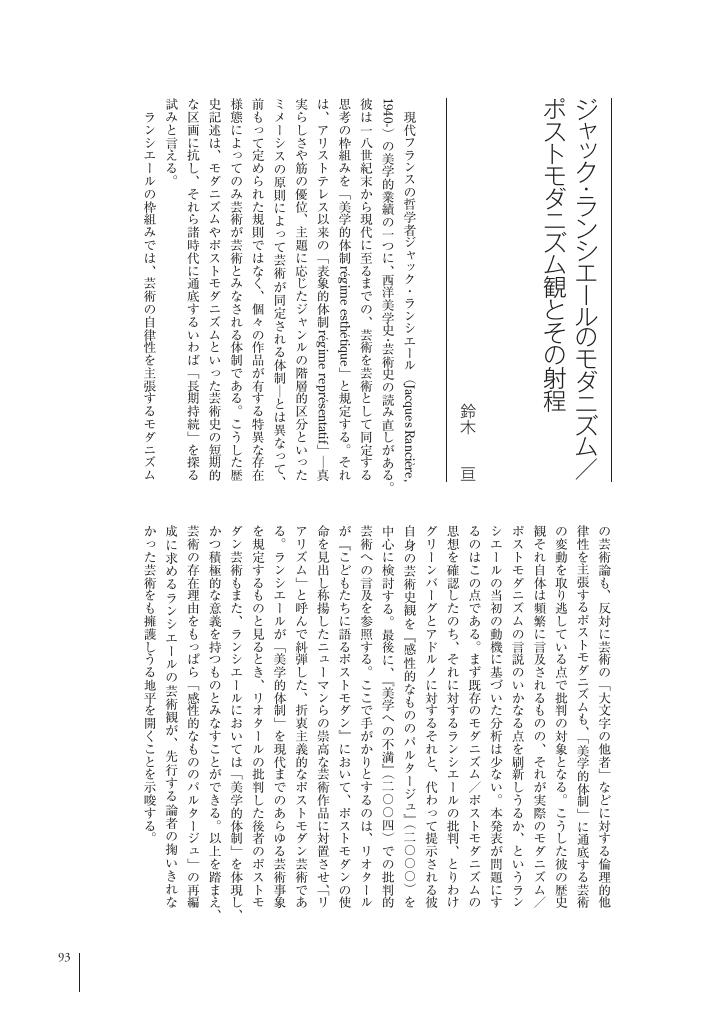1 0 0 0 OA 「ある善良な男」とは誰なのか シャルル=バランタン・アルカン作《葬送行進曲》の一考察
- 著者
- 村井 幸輝郎
- 出版者
- 美学会
- 雑誌
- 美学 (ISSN:05200962)
- 巻号頁・発行日
- vol.67, no.2, pp.103, 2016 (Released:2018-01-01)
- 著者
- 森 結
- 出版者
- 美学会
- 雑誌
- 美学 (ISSN:05200962)
- 巻号頁・発行日
- vol.67, no.2, pp.104, 2016 (Released:2018-01-01)
1 0 0 0 OA 身体と言語 道感の質的記述の試みから見えてくるもの
- 著者
- 柿沼 美穂
- 出版者
- 美学会
- 雑誌
- 美学 (ISSN:05200962)
- 巻号頁・発行日
- vol.67, no.2, pp.87, 2016 (Released:2018-01-01)
- 著者
- 片桐 亜古
- 出版者
- 美学会
- 雑誌
- 美学 (ISSN:05200962)
- 巻号頁・発行日
- vol.67, no.2, pp.88, 2016 (Released:2018-01-01)
1 0 0 0 OA テープ・レコーダーとして表現された主体 高見沢文雄《柵を越えた羊の数》
- 著者
- 金子 智太郎
- 出版者
- 美学会
- 雑誌
- 美学 (ISSN:05200962)
- 巻号頁・発行日
- vol.67, no.2, pp.89, 2016 (Released:2018-01-01)
1 0 0 0 OA 二次元的人間の予知夢 アドルフ・ヒルデブランt
- 著者
- 金田 千秋
- 出版者
- 美学会
- 雑誌
- 美学 (ISSN:05200962)
- 巻号頁・発行日
- vol.67, no.2, pp.90, 2016 (Released:2018-01-01)
1 0 0 0 OA バウムガルテンの美的真理と形而上学的真理 可能的なものの存在論をめぐって
- 著者
- 桑原 俊介
- 出版者
- 美学会
- 雑誌
- 美学 (ISSN:05200962)
- 巻号頁・発行日
- vol.67, no.2, pp.91, 2016 (Released:2018-01-01)
1 0 0 0 OA 美的性質の知覚と存在論 レヴィンソンの美的知覚説の検討と代替案の提示
- 著者
- 源河 亨
- 出版者
- 美学会
- 雑誌
- 美学 (ISSN:05200962)
- 巻号頁・発行日
- vol.67, no.2, pp.92, 2016 (Released:2018-01-01)
1 0 0 0 OA ジャック・ランシエールのモダニズム ポストモダニズム観とその射程
- 著者
- 鈴木 亘
- 出版者
- 美学会
- 雑誌
- 美学 (ISSN:05200962)
- 巻号頁・発行日
- vol.67, no.2, pp.93, 2016 (Released:2018-01-01)
- 著者
- 田口 かおり
- 出版者
- 美学会
- 雑誌
- 美学 (ISSN:05200962)
- 巻号頁・発行日
- vol.67, no.2, pp.94, 2016 (Released:2018-01-01)
1 0 0 0 OA 変形理論とシェンカー理論 解釈の方法の優位性について
- 著者
- 西田 紘子
- 出版者
- 美学会
- 雑誌
- 美学 (ISSN:05200962)
- 巻号頁・発行日
- vol.67, no.2, pp.95, 2016 (Released:2018-01-01)
1 0 0 0 OA 描き始める前に 『感覚の論理』における創造のプロセス
- 著者
- 安藤 勝哉
- 出版者
- 美学会
- 雑誌
- 美学 (ISSN:05200962)
- 巻号頁・発行日
- vol.67, no.2, pp.73, 2016 (Released:2018-01-01)
1 0 0 0 OA バタイユのエロティスム論におけるイメージの使用と意義 『エロスの涙』考察
- 著者
- 井岡 詩子
- 出版者
- 美学会
- 雑誌
- 美学 (ISSN:05200962)
- 巻号頁・発行日
- vol.67, no.2, pp.80, 2016 (Released:2018-01-01)
1 0 0 0 OA 彼女の人生を生きる 原一男監督『極私的エロス・恋歌一九七四』をめぐって
- 著者
- 今村 純子
- 出版者
- 美学会
- 雑誌
- 美学 (ISSN:05200962)
- 巻号頁・発行日
- vol.67, no.2, pp.81, 2016 (Released:2018-01-01)
1 0 0 0 OA 高松次郎《題名》における同時代性と独自性 もの派との比較より
- 著者
- 大澤 慶久
- 出版者
- 美学会
- 雑誌
- 美学 (ISSN:05200962)
- 巻号頁・発行日
- vol.67, no.2, pp.82, 2016 (Released:2018-01-01)
1 0 0 0 OA 「凌駕しえない充実」と「絶対的な充実」
- 著者
- 大道 周作
- 出版者
- 美学会
- 雑誌
- 美学 (ISSN:05200962)
- 巻号頁・発行日
- vol.67, no.2, pp.83, 2016 (Released:2018-01-01)
1 0 0 0 OA 散漫な聴取の効果 おもに一八世紀後半におけるズルツァーらのリズム論から
- 著者
- 岡野 宏
- 出版者
- 美学会
- 雑誌
- 美学 (ISSN:05200962)
- 巻号頁・発行日
- vol.67, no.2, pp.84, 2016 (Released:2018-01-01)
1 0 0 0 OA アンドレ・ブルトンと想像力の問題 シュルレアリスムとルネサンスのあいだで
- 著者
- 岡本 源太
- 出版者
- 美学会
- 雑誌
- 美学 (ISSN:05200962)
- 巻号頁・発行日
- vol.67, no.2, pp.85, 2016 (Released:2018-01-01)
1 0 0 0 OA フルクサスにおける「イヴェント」再考 ジョージ・ブレクトの実践を中心に
- 著者
- 小野寺 奈津
- 出版者
- 美学会
- 雑誌
- 美学 (ISSN:05200962)
- 巻号頁・発行日
- vol.67, no.2, pp.86, 2016 (Released:2018-01-01)
1 0 0 0 OA 〈パリのイロクォイ人〉と〈孤島のロビンソン〉 カント美学と文明化の過程
- 著者
- 小田部 胤久
- 出版者
- 美学会
- 雑誌
- 美学 (ISSN:05200962)
- 巻号頁・発行日
- vol.67, no.2, pp.1-12, 2016 (Released:2018-01-01)
In section 2 of the third Critique (1790) Kant refers to the Iroquois sachem who said the cook-shops (not the palace) in Paris pleased him. The sachem seems to be a barbarian ensnared by appetite and incapable of disinterested pleasure. My paper, however, argues first that Kant, extracting this episode from “The History of New France” (1744) written by a French Jesuit missionary, Charlevoix, tacitly advocates the idea of the noble savage, thereby giving the Iroquois sachem the function of criticizing a luxurious civilization. Second, I show that in the “General Remark on the exposition of aesthetic reflective judgments,” Kant positively evaluates a castaway Crusoe (who is put together in one context with the Iroquois sachem in section 2) as a person who withdraws from civilized society with the consciousness that society is far from the moral ideal. The Iroquois sachem and the castaway Crusoe are examples that anticipate section 83 in the second part of the third Critique, which focuses on the role of the faculty of taste in the process of civilization, thereby incorporating Kant’s theory of taste in the first part of the third Critique into his whole system.


















